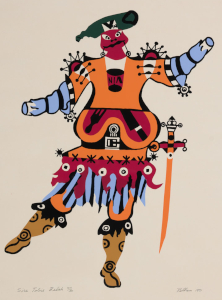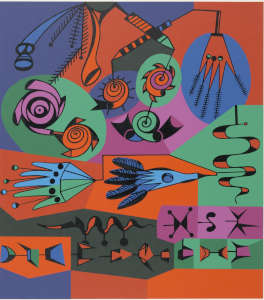sold artworks
Alfred Pellan, C.C., O.Q., LL.D., R.C.A.
Canadian , 1906 - 1988
Born: Canada: Quebec, Quebec 1906-05-16
Died: Canada: Quebec, Montreal 1988-10-31
Selected works
Biography
The art of Alfred Pellan progressed from representational images to abstracted simplified forms and surrealist images. He also painted murals, designed theatre costumes and stained glass, and illustrated books. Girl with Anemones (1932), an early painting that contrasts shape, colour and line, bridges his representational images and later abstract interests.
In 1920 Pellan enrolled at the École des Beaux-Arts in Quebec City. His talent was quickly recognized and the National Gallery of Canada bought his painting A Corner of Old Quebec (1922) when he was only seventeen. He was awarded a Quebec government scholarship in 1926 to go to Paris, where he worked in the studio of Lucien Simon for four years and studied at the École des Beaux-Arts. He revelled in the contemporary art scene, familiarizing himself with the work of Van Gogh, Matisse, Picasso, and Miró, among others. It was through these artists’ fractured and abstracted forms, bold use of colour, and flattening of three-dimensional space that Pellan found his own artistic direction.
Pellan had his first solo exhibition in Paris at the Académie Ranson in 1935. At this time he also worked as a graphic designer and designed fabric for the well-known couturier Schiaparelli. He was included in the 1939 Washington exhibition Paris Painters of Today, along with Picasso, Derain, Dufy, and Dalí. With the outbreak of the Second World War, Pellan returned to Quebec and had two exhibitions of his Parisian production in Quebec City and Montreal, which had an enormous catalyzing influence on the local artists. He settled in Montreal, and in 1943 he was put in charge of the advanced painting course at the École des Beaux-Arts. In addition to drawing and painting he illustrated books and provided set and costume designs for a 1946 Montreal theatre production of Shakespeare’s La Nuit des rois (Twelfth Night). Pellan was a leader of the short-lived Prisme d’Yeux (1948), a group that sought an art “freed from all bonds of time and place, and of restrictive ideology … that can adulterate its expression or compromise its purity.”
Pellan left teaching in 1952 and travelled to Paris on a research fellowship from the Royal Society of Canada. He stayed for three years, culminating in a retrospective of his work in 1955 at the Musée d’Art moderne de la Ville de Paris. He continued to paint and exhibit in Montreal following his retur













